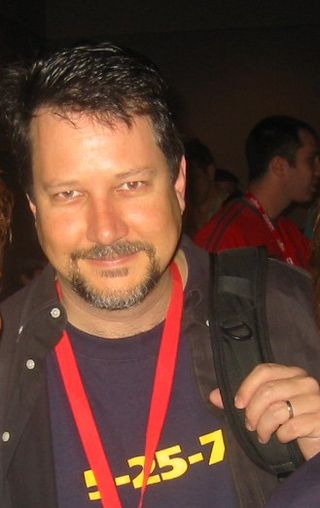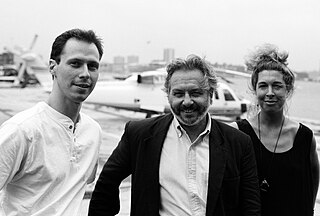Related Research Articles

Framestore is a British visual effects and computer animation studio based on Chancery Lane in London, England. The company was founded in 1986. Framestore specializes in visual effects for film and prestige TV, advertising, rides, and immersive experiences. It is the largest production house in Europe, employing roughly 3,000 staff, including 1,000 in London, and 1,500 across studios in Chicago, New York, Los Angeles, Montreal, Melbourne and Mumbai.

The Academy Award for Best Visual Effects is presented annually by the Academy of Motion Picture Arts and Sciences (AMPAS) for the best achievement in visual effects. It has been handed to four members of the team directly responsible for creating the film's visual effects since 1980.

John Knoll is an American visual effects supervisor and chief creative officer (CCO) at Industrial Light & Magic (ILM). One of the original creators of Adobe Photoshop, he has also worked as visual effects supervisor on the Star Wars prequels and the 1997 special editions of the original trilogy. He also served as ILM's visual effects supervisor for Star Trek Generations and Star Trek: First Contact, as well as the Pirates of the Caribbean series. Along with Hal Hickel, Charles Gibson and Allen Hall, Knoll and the trio's work on Pirates of the Caribbean: Dead Man's Chest earned them the Academy Award for Best Visual Effects.

Sir Roger Alexander Deakins is an English cinematographer. He is the recipient of five BAFTA Awards for Best Cinematography, and two Academy Awards for Best Cinematography from sixteen nominations. He has collaborated multiple times with directors such as the Coen brothers, Sam Mendes, and Denis Villeneuve. His best-known works include The Shawshank Redemption (1994), Fargo (1996), O Brother, Where Art Thou? (2000), A Beautiful Mind (2001), Skyfall (2012), Sicario (2015), Blade Runner 2049 (2017), and 1917 (2019), the last two of which earned him Academy Awards.
DNEG is a British-Indian visual effects, computer animation and 3-D conversion studio that was founded in 1998 in London, and rebranded as DNEG in 2014 after a merger with Indian VFX company Prime Focus; it was named after the letters "D" and "Neg" from their former name.

Craig Barron is an American visual effects artist and creative director at Magnopus, a media company that produces visual development and virtual production services for motion pictures, television, museums and multimedia platforms.
Habib Zargarpour is an Iranian visual effects supervisor, computer graphics supervisor, art director and creative director.
Gregory S. Butler is an Academy Award-winning American visual effects supervisor. He graduated from Suffield High School in 1989 and afterwards entered Hampshire College. Despite his initial plans to study history, a work-study job with the audiovisual equipment in the library made him interested in film production. Butler graduated in 1993 with a major in film, television and theater design. Afterwards he moved to California to work for Industrial Light and Magic for 9 months, where after intern work he managed to become an assistant in the effects department, starting with assistant credits in The Mask and Forrest Gump. Following a job at Rocket Science Games until the company's bankruptcy in 1996, Butler went to Tippett Studio and did effects work in Starship Troopers and My Favorite Martian, rising up to a technical director job, and Cinesite for Practical Magic. While reluctant at the requirement of moving to New Zealand, Butler was convinced by his writer-actor brother to jump at the opportunity of working for Weta Digital in The Lord of the Rings. Among his achievements was working on the creation of Gollum. for which he was awarded a Visual Effects Society Award.
Paul J. Franklin is an English visual effects supervisor who has worked with visual effects since the 1990s. Franklin won the Academy Award for Best Visual Effects and the BAFTA Award for Best Special Visual Effects for Inception (2010), and won a second Academy Award for Best Visual Effects for Interstellar (2014). He shared the wins with Andrew Lockley, Peter Bebb, and Chris Corbould. Franklin has also been nominated for an Academy Award for The Dark Knight (2008). He was nominated for BAFTA Awards for Batman Begins, The Dark Knight (2008), and The Dark Knight Rises (2012).
Christopher Townsend is a Visual Effects Supervisor. He has worked in the visual effects industry for nearly 30 years. For over a decade, he was an artist and supervisor at Industrial Light and Magic, and in 2007 became a freelance visual effects supervisor. He worked on Journey to the Center of the Earth, the first ever stereoscopic motion picture shot and released digitally, The Wolverine, Ninja Assassin, Percy Jackson & the Olympians: The Lightning Thief and Captain America: The First Avenger. He was nominated for a BAFTA and an Academy Award for Best Visual Effects for his work on Iron Man 3, oversaw nearly 3000 shots on Avengers: Age of Ultron and was the overall supervisor for Guardians of the Galaxy Vol. 2, for which he received his second nomination for an Academy Award for Best Visual Effects. He was the overall Production VFX Supervisor on Captain Marvel, and following that, for his work on Shang-Chi and the Legend of the Ten Rings, was once again nominated for an Academy Award for Best Visual Effects. For his first foray into television and streaming, in 2024 he was nominated for an Emmy, for his overall VFX Supervising on the second season of the Disney+ show Loki.

John Bruno is an American visual effects artist and filmmaker known for his prolific collaborations with director James Cameron on films like Terminator 2: Judgment Day, True Lies, Titanic, Avatar, and The Abyss, for which he won the Academy Award for Best Visual Effects.
Richard R. Hoover is a visual effects artist noted for his work on Armageddon, Superman Returns and Blade Runner 2049.

Ian Hunter is a visual effects artist. He won two Academy Awards for Best Visual Effects for the 2014 film, Interstellar, at the 87th Academy Awards in 2015 and for the 2018 film, First Man, at the 91st Academy Awards in 2019.

Sara Bennett is an Oscar-winning Visual Effects Supervisor and co-founder of Milk - a visual effects studio headquartered in London. Bennett was born in Worcestershire in the West of England.

Milk VFX is a British independent visual effects studio. It was founded in London in 2013 and is known for creating complex and innovative sequences for high-end television and feature films.

Blade Runner 2049 – Original Motion Picture Soundtrack is the soundtrack album for the 2017 film Blade Runner 2049. Released in October 2017, the album contains music composed by Hans Zimmer and Benjamin Wallfisch, along with additional tracks by Elvis Presley, Frank Sinatra and Lauren Daigle. The soundtrack was produced by Michael Hodges, Kayla Morrison and Ashley Culp. It also includes the piece "Tears in the Rain", which was originally composed and performed by Vangelis, the composer of the original 1982 soundtrack Blade Runner.
Paul Lambert is an English visual effects supervisor at Wylie Co. He has won three Academy Awards for Best Visual Effects: one for the 2017 film Blade Runner 2049 at the 90th Academy Awards, one for the 2018 film First Man at the 91st Academy Awards., and his recent one in 2022, at the 94th Academy Awards, for his work on Dune.
Gerd Nefzer is a German special effects artist. He won an Academy Award for Best Visual Effects for his work as a special effects supervisor on Blade Runner 2049. He shared the award with John Nelson, Paul Lambert and Richard R. Hoover.
David Lee is a New Zealand visual effects supervisor. He won an Academy Award in the category Best Visual Effects for the film Tenet.
References
- ↑ "73rd Academy Awards Winners Oscar Legacy Academy of Motion Picture Arts and Sciences". Oscars.org. March 25, 2001. Archived from the original on April 14, 2012. Retrieved July 25, 2012.
- ↑ "The 90th Academy Awards". Oscars.org. November 25, 2020. Retrieved November 25, 2020.
- ↑ "77th Academy Awards Winners Oscar Legacy Academy of Motion Picture Arts and Sciences". Oscars.org. February 27, 2005. Archived from the original on June 10, 2014. Retrieved November 2, 2012.
- ↑ "81st Academy Awards Winners Oscar Legacy Academy of Motion Picture Arts and Sciences". Oscars.org. February 22, 2009. Retrieved November 2, 2012.
- ↑ "SPECIAL VISUAL EFFECTS - BLADE RUNNER 2049". bafta.org. November 25, 2020. Retrieved November 25, 2020.
- ↑ Robertson, Barbara (September 27, 2018), VFX Supervisor John Nelson: Looking Through the Lens for Perfection, VFX Voice, retrieved October 22, 2018